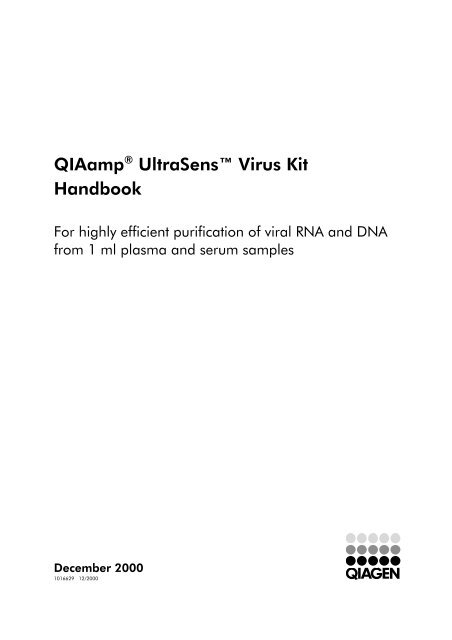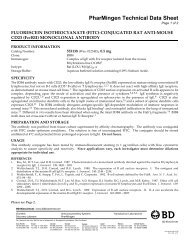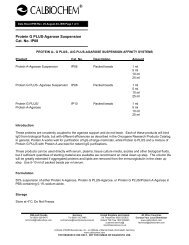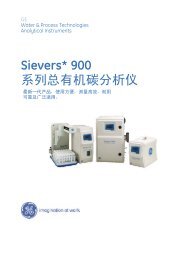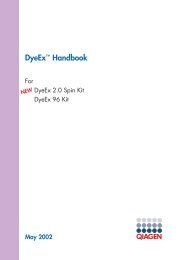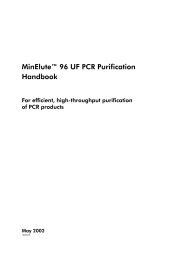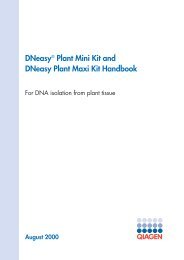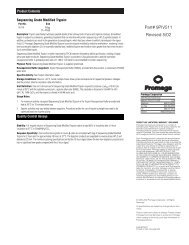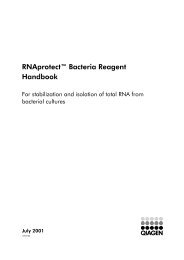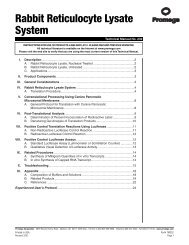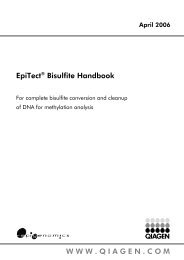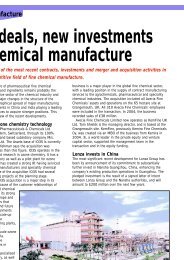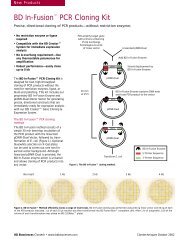QIAamp UltraSens Virus Kit Handbook 12/00 (PDF
QIAamp UltraSens Virus Kit Handbook 12/00 (PDF
QIAamp UltraSens Virus Kit Handbook 12/00 (PDF
Create successful ePaper yourself
Turn your PDF publications into a flip-book with our unique Google optimized e-Paper software.
<strong>QIAamp</strong> ® <strong>UltraSens</strong> <strong>Virus</strong> <strong>Kit</strong><br />
<strong>Handbook</strong><br />
For highly efficient purification of viral RNA and DNA<br />
from 1 ml plasma and serum samples<br />
December 2<strong>00</strong>0<br />
1016629 <strong>12</strong>/2<strong>00</strong>0
Trademarks<br />
Patented or patent-pending and/or registered or registration-pending trademark of QIAGEN:<br />
QIAGEN ® , <strong>QIAamp</strong> ® , <strong>UltraSens</strong>, OmniScript, HotStarTaq.<br />
The PCR process is covered by US Patents 4,683,195 and 4,683,202 and foreign equivalents<br />
issued to Hoffmann–La Roche AG.<br />
Eppendorf is a registered trademark of Eppendorf-Netheler-Hinz GmbH.<br />
Corex is a registered trademark of Corning, Inc.<br />
Registered names, trademarks, etc. used in this document, even when not specifically marked<br />
as such, are not to be considered unprotected by law.<br />
© 2<strong>00</strong>0 QIAGEN, all rights reserved.
Contents<br />
<strong>Kit</strong> Contents 4<br />
Storage Conditions 5<br />
Equipment and Reagents to Be Supplied by User 5<br />
Product Use Limitations 6<br />
Product Warranty and Satisfaction Guarantee 6<br />
Technical Assistance 7<br />
Safety Information 8<br />
Introduction 9<br />
The <strong>QIAamp</strong> <strong>UltraSens</strong> Principle and Procedure 9<br />
Centrifugation 9<br />
Sample types 10<br />
Important Notes Before Starting <strong>12</strong><br />
Internal controls <strong>12</strong><br />
Centrifugation optimization <strong>12</strong><br />
Sample storage 13<br />
Preparation of reagents 13<br />
Handling of <strong>QIAamp</strong> Spin Columns 15<br />
<strong>QIAamp</strong> <strong>UltraSens</strong> <strong>Virus</strong> Protocol 16<br />
Troubleshooting Guide 20<br />
Appendix 23<br />
Handling RNA 23<br />
General handling 23<br />
Disposable plasticware 23<br />
Non-disposable plasticware 23<br />
Glassware 23<br />
Electrophoresis tanks 24<br />
Solutions 24<br />
QIAGEN International Sales and Distributors 27<br />
<strong>QIAamp</strong> <strong>UltraSens</strong> <strong>Virus</strong> <strong>Kit</strong> <strong>Handbook</strong> <strong>12</strong>/2<strong>00</strong>0 3
<strong>Kit</strong> Contents<br />
Cat. No. 53704 53706<br />
Number of Preparations per<br />
<strong>Kit</strong><br />
50 250<br />
<strong>QIAamp</strong> ® Spin Columns 50 250<br />
Collection tubes (2 ml) 150 750<br />
Buffer AC 46 ml 230 ml<br />
Buffer AR* 20 ml 90 ml<br />
Buffer AB (concentrate) 5 ml 22 ml<br />
Buffer AW1* (concentrate) 19 ml 95 ml<br />
Buffer AW2 † (concentrate) 13 ml 66 ml<br />
Buffer AVE 3 x 2 ml 10 x 2 ml<br />
Proteinase K 1.25 ml 6 ml<br />
Carrier RNA 310 µg 5 x 310 µg<br />
<strong>Handbook</strong> 1 1<br />
* Contains chaotropic salt which is an irritant. Take appropriate laboratory safety measures,<br />
and wear gloves when handling. Not compatible with disinfecting agents which contain<br />
bleach.<br />
†<br />
Contains sodium azide. Take appropriate safety measures, and wear gloves when handling.<br />
Dispose of solutions containing azide according to your institution’s waste-disposal guidelines.<br />
4 <strong>QIAamp</strong> <strong>UltraSens</strong> <strong>Virus</strong> <strong>Kit</strong> <strong>Handbook</strong> <strong>12</strong>/2<strong>00</strong>0
Storage Conditions<br />
<strong>QIAamp</strong> spin columns should be stored dry at room temperature (15–25°C);<br />
storage at higher temperatures should be avoided. All buffers and reagents<br />
should be stored at room temperature unless otherwise stated. After receiving<br />
the kit, <strong>QIAamp</strong> spin columns, buffers, and reagents can be stored for up to<br />
7 months under the above conditions without showing any reduction in<br />
performance.<br />
Lyophilized carrier RNA is stable for up to 1 year when stored at room<br />
temperature. Carrier RNA dissolved in Buffer AVE (supplied with the kit) should<br />
be aliquoted and stored at –20°C (see ”Preparation of reagents”, page 13).<br />
When dissolved in this manner, it is stable for 1 year at –20°C.<br />
The ready-to-use QIAGEN ® Proteinase K solution is stable for up to one year<br />
after delivery when stored at room temperature. To prolong the lifetime of<br />
QIAGEN Proteinase K, storage at 2–8°C is recommended.<br />
Equipment and Reagents to Be Supplied by User<br />
• Ethanol (96–1<strong>00</strong> %)<br />
• Sterile, RNase-free pipet tips with aerosol barrier<br />
• RNase-free microcentrifuge tubes (1.5 ml and 2 ml)<br />
• Disposable gloves<br />
• Phosphate-buffered saline (PBS) may be required for samples larger than 1 ml<br />
• Variable-speed microcentrifuge, adjustable between 250 and <strong>12</strong><strong>00</strong> x g, with<br />
a rotor for 2 ml microcentrifuge tubes<br />
• A shaker–incubator, for example the Eppendorf ® Thermomixer Compact, or<br />
a heating block.<br />
<strong>QIAamp</strong> <strong>UltraSens</strong> <strong>Virus</strong> <strong>Kit</strong> <strong>Handbook</strong> <strong>12</strong>/2<strong>00</strong>0 5
Product Use Limitations<br />
<strong>QIAamp</strong> <strong>Kit</strong>s are intended as general-purpose devices. No claim or<br />
presentation is intended for their use to identify any specific organism or for<br />
clinical use (diagnostic, prognostic, therapeutic, or blood banking). It is the<br />
users responsibility to validate the performance of <strong>QIAamp</strong> <strong>Kit</strong>s for any<br />
particular use, since the performance characteristics of these kits have not been<br />
validated for any specific organism. <strong>QIAamp</strong> <strong>Kit</strong>s may be used in clinical<br />
diagnostic laboratory systems after the laboratory has validated their complete<br />
system as required by CLIA’88 regulations in the U.S. or equivalents in other<br />
countries.<br />
All due care and attention should be exercised in the handling of the products.<br />
We recommend all users of QIAGEN products to adhere to the NIH guidelines<br />
that have been developed for recombinant DNA experiments, or to other<br />
applicable guidelines.<br />
Product Warranty and Satisfaction Guarantee<br />
QIAGEN guarantees the performance of all products in the manner described<br />
in our product literature. The purchaser must determine the suitability of the<br />
product for its particular use. Should any product fail to perform satisfactorily<br />
due to any reason other than misuse, QIAGEN will replace it free of charge or<br />
refund the purchase price. We reserve the right to change, alter, or modify any<br />
product to enhance its performance and design. If a QIAGEN product does not<br />
meet your expectations, simply call your local Technical Service Department or<br />
distributor. We will credit your account or exchange the product — as you wish.<br />
A copy of QIAGEN terms and conditions can be obtained on request, and is<br />
also provided on the back of our invoices. If you have questions about product<br />
specifications or performance, please call QIAGEN Technical Services or your<br />
local distributor (listed on the last page).<br />
6 <strong>QIAamp</strong> <strong>UltraSens</strong> <strong>Virus</strong> <strong>Kit</strong> <strong>Handbook</strong> <strong>12</strong>/2<strong>00</strong>0
Technical Assistance<br />
At QIAGEN we pride ourselves on the quality and availability of our technical<br />
support. Our Technical Service Departments are staffed by experienced<br />
scientists with extensive practical and theoretical expertise in molecular biology<br />
and the use of QIAGEN products. If you have any questions or experience any<br />
difficulties regarding the <strong>QIAamp</strong> <strong>UltraSens</strong> <strong>Virus</strong> <strong>Kit</strong> or QIAGEN products in<br />
general, please do not hesitate to contact us.<br />
QIAGEN customers are a major source of information regarding advanced or<br />
specialized uses of our products. This information is helpful to other scientists as<br />
well as to the researchers at QIAGEN. We therefore encourage you to contact<br />
us if you have any suggestions about product performance or new applications<br />
and techniques.<br />
For technical assistance and more information please call one of the QIAGEN<br />
Technical Service Departments or local distributors listed on the last page.<br />
<strong>QIAamp</strong> <strong>UltraSens</strong> <strong>Virus</strong> <strong>Kit</strong> <strong>Handbook</strong> <strong>12</strong>/2<strong>00</strong>0 7
Safety Information<br />
CAUTION: DO NOT add bleach or acidic solutions directly to the<br />
sample-preparation waste.<br />
The sample-preparation waste contains guanidine hydrochloride from Buffers<br />
AW1 and AR, which can form highly reactive compounds when combined with<br />
bleach.<br />
In case liquid containing these buffers is spilt, clean with suitable laboratory<br />
detergent and water. If the spilt liquid contains potentially infectious agents,<br />
clean the affected area first with laboratory detergent and water, and then with<br />
1% (v/v) sodium hypochlorite.<br />
Below is listed European Community risk and safety phrases for the components<br />
of the <strong>QIAamp</strong> <strong>UltraSens</strong> <strong>Virus</strong> <strong>Kit</strong> to which they apply.<br />
Buffer AC<br />
Caution: this buffer contains isopropanol and a substance whose safety<br />
characteristics are as yet not fully determined. Isopropanol: flammable. Risk<br />
and safety phrases:* R10<br />
Buffer AB<br />
Contains ethanol and Nonidet P40: irritant. Risk and safety phrases:* R10,<br />
R36/38, R41, S2, S13, S26, S46<br />
Buffers AR and AW1<br />
Contain guanidine hydrochloride: harmful, irritant. Risk and safety phrases:*<br />
R22, R36/38, S2, S13, S26, S36, S46<br />
Proteinase K<br />
Proteinase K: sensitizer, irritant. Risk and safety phrases:* R36/37/38, R42/43,<br />
S23, S24, S26, S36/37, S45<br />
* R10: Flammable; R22: Harmful if swallowed; R36/38: Irritating to eyes and skin; R36/37/38:<br />
Irritating to eyes, respiratory system and skin; R41: Risk of serious damage to eyes; R42/43:<br />
May cause sensitization by inhalation and skin contact; S2: Keep out of the reach of children;<br />
S13: Keep away from food, drink and animal feed; S23: Do not breathe vapor; S24: Avoid<br />
contact with skin; S26: In case of contact with eyes, rinse immediately with plenty of water<br />
and seek medical advice; S36: Wear suitable protective clothing; S36/37: Wear suitable<br />
protective clothing and gloves; S46: If swallowed, seek medical advice immediately and show<br />
this container or label; S45: In case of accident or if you feel unwell, seek medical advice<br />
immediately (show this notice where possible)<br />
8 <strong>QIAamp</strong> <strong>UltraSens</strong> <strong>Virus</strong> <strong>Kit</strong> <strong>Handbook</strong> <strong>12</strong>/2<strong>00</strong>0
Introduction<br />
The <strong>QIAamp</strong> ® <strong>UltraSens</strong> <strong>Virus</strong> <strong>Kit</strong> is designed for rapid, highly sensitive and<br />
efficient recovery of viral RNA and DNA from plasma or serum. New <strong>QIAamp</strong><br />
<strong>UltraSens</strong> technology is used to greatly concentrate viral nucleic acids in<br />
samples, allowing downstream detection of very low viral titers. Contaminants<br />
and enzyme inhibitors are efficiently removed by the <strong>QIAamp</strong> purification<br />
procedure, which is based on advanced silica-gel–membrane technology and<br />
uses no phenol, chloroform, or other organic solvents. The <strong>QIAamp</strong> <strong>UltraSens</strong><br />
procedure is designed to allow the inclusion of internal controls with the<br />
samples in the initial step, allowing the entire purification process to be<br />
accurately monitored. <strong>QIAamp</strong> purified nucleic acids are ideal for use in all<br />
downstream amplification-based assays.<br />
The <strong>QIAamp</strong> <strong>UltraSens</strong> Principle and Procedure<br />
<strong>QIAamp</strong> <strong>UltraSens</strong> technology allows viral RNA and DNA from 1 ml plasma or<br />
serum samples to be highly concentrated in a single step, prior to purification<br />
using <strong>QIAamp</strong> silica-gel–membrane technology. Ultracentrifugation and<br />
specialized laboratory equipment are not required.<br />
Buffer AC contains a reagent that forms complexes with nucleic acids, and<br />
these complexes can be sedimented by low–g-force centrifugation to form a<br />
pellet. This pellet can then be resuspended in a small volume of buffer prior to<br />
nucleic acid purification using the <strong>QIAamp</strong> procedure, enabling extremely<br />
efficient and sensitive viral nucleic acid isolation.<br />
Buffer AC and carrier RNA are added to a plasma or serum sample. After a<br />
short incubation step the sample is centrifuged at low speed to pellet the nucleic<br />
acid complexes. The supernatant is discarded, and the pellet is resuspended in<br />
Buffer AR and proteinase K, and incubated for 10 min at an elevated<br />
temperature. Binding conditions are adjusted by adding Buffer AB, and the<br />
lysate is applied to a <strong>QIAamp</strong> spin column. During a brief centrifugation, RNA<br />
and DNA are selectively bound to the <strong>QIAamp</strong> membrane as contaminants<br />
pass through. Remaining contaminants and enzyme inhibitors are efficiently<br />
removed by centrifugation in two wash steps, and the pure viral nucleic acids<br />
are eluted in low-salt Buffer AVE.<br />
Centrifugation<br />
<strong>QIAamp</strong> <strong>UltraSens</strong> technology requires very-low-speed centrifugation. The<br />
nucleic acid complexes are sedimented by very low g-forces (<strong>12</strong><strong>00</strong> x g). Lower<br />
g-forces may reduce yield due to incomplete recovery of the complexes,<br />
whereas higher g-forces can lead to formation of hard pellets that are very<br />
difficult to resuspend subsequently. It is also important to centrifuge the<br />
<strong>QIAamp</strong> <strong>UltraSens</strong> <strong>Virus</strong> <strong>Kit</strong> <strong>Handbook</strong> <strong>12</strong>/2<strong>00</strong>0 9
<strong>QIAamp</strong> spin column at very low speeds (~250 x g) during the nucleic acid<br />
binding step. This ensures maximum nucleic acid recovery.<br />
Note: For best results, depending on your microcentrifuge model, the g-force<br />
required for centrifugation in step 5 of the protocol may need optimization (see<br />
“Important Notes Before Starting”, page <strong>12</strong>).<br />
Sample types<br />
The <strong>QIAamp</strong> <strong>UltraSens</strong> protocol is designed for isolation of viral nucleic acids<br />
(e.g., those of HIV, HCV, or HBV) from 1 ml plasma or serum, or 1 ml from a<br />
pool of such cell-free body fluids. Such pools can consist of many samples from<br />
individual donors, and are usually more homogeneous than samples from<br />
single donors.<br />
Note: If you use the <strong>QIAamp</strong> <strong>UltraSens</strong> <strong>Virus</strong> <strong>Kit</strong> to purify nucleic acids from<br />
other types of samples, you may have to optimize the g-force used during<br />
centrifugation to ensure maximum yield. The optimal g-force depends on the<br />
type of sample: sample types with lower protein contents than plasma or serum<br />
may need more than the recommended <strong>12</strong><strong>00</strong> x g to fully pellet the detergent–<br />
nucleic acid complexes.<br />
<strong>QIAamp</strong> <strong>UltraSens</strong> technology may not work well with plasma samples that<br />
contain unusually high amounts of lipids, and recovery of viral nucleic acids<br />
from such samples may be reduced. Reduced pellet size can be an indication<br />
that the reagent in Buffer AC is interacting with lipids in the sample. See the<br />
troubleshooting guide on page 20 for strategies to overcome this problem.<br />
10 <strong>QIAamp</strong> <strong>UltraSens</strong> <strong>Virus</strong> <strong>Kit</strong> <strong>Handbook</strong> <strong>12</strong>/2<strong>00</strong>0
The <strong>QIAamp</strong> <strong>UltraSens</strong> <strong>Virus</strong> procedure<br />
<strong>QIAamp</strong> <strong>UltraSens</strong> <strong>Virus</strong> <strong>Kit</strong> <strong>Handbook</strong> <strong>12</strong>/2<strong>00</strong>0 11
Important Notes Before Starting<br />
If preparing RNA for the first time, read “Handling RNA” in the appendix (page<br />
23) before starting. All steps of the protocol should be performed quickly and at<br />
room temperature (15–25°C).<br />
Internal controls<br />
An internal control can be added to the sample together with the carrier RNA<br />
and Buffer AC in step 2. If only a small volume of internal control is added to<br />
the sample, it may be worthwhile to prepare a master mix of carrier RNA and<br />
internal control. Thus, a larger volume (which can be more accurately pipetted,<br />
reducing sample-to-sample variability) can be added to each sample in only a<br />
single pipetting step.<br />
Note: Plasma and serum are rich in RNases. Do not add carrier RNA or an<br />
internal control RNA directly to untreated samples.<br />
Centrifugation optimization<br />
The centrifugation steps (5 and <strong>12</strong>) in the protocol are key to optimal nucleic<br />
acid recovery. A centrifuge with adjustable g-force is highly recommended for<br />
use with this protocol. If no such centrifuge is available, the g-force can be<br />
calculated as follows:<br />
rcf = 1.<strong>12</strong> × r × (rpm/1<strong>00</strong>0) 2<br />
Where rcf is the relative centrifugal force (in g), r is the radius of the rotor in<br />
centimeters, and rpm is the speed of the centrifuge in revolutions per minute.<br />
Step 5: Pelleting the nucleic acid–detergent complexes<br />
Too high a g-force can lead to a pellet that is highly compressed and difficult to<br />
resuspend. In rare cases, it may be necessary to optimize the g-force used in<br />
some microcentrifuge models. If the pellet is too solid after centrifugation at<br />
<strong>12</strong><strong>00</strong> x g, decrease the g-force in 1<strong>00</strong> x g steps with each preparation to find<br />
the g-force at which a pellet that is easy to resuspend is formed, but at which<br />
the supernatant is free of debris. If debris is present after centrifugation,<br />
increase the g-force in 1<strong>00</strong> x g steps with each preparation until it is no longer<br />
present in the supernatant.<br />
Once the correct g-force has been found for a particular centrifuge, it can be<br />
used for all plasma and serum samples in that centrifuge — no changes need<br />
be made.<br />
Step <strong>12</strong>: Binding nucleic acids to the <strong>QIAamp</strong> membrane<br />
A very low g-force (250 x g) is necessary at this step to ensure that the<br />
complexed nucleic acids have sufficient opportunity to bind to the <strong>QIAamp</strong><br />
<strong>12</strong> <strong>QIAamp</strong> <strong>UltraSens</strong> <strong>Virus</strong> <strong>Kit</strong> <strong>Handbook</strong> <strong>12</strong>/2<strong>00</strong>0
membrane. Higher g-forces may lead to loss of nucleic acids in the spincolumn<br />
flow-through.<br />
Sample storage<br />
After collection and centrifugation, plasma or serum samples can be stored at<br />
2–8°C for up to 6 hours. For long-term storage, freezing aliquots at –20°C to<br />
–80°C is recommended. Frozen plasma or serum samples should not be<br />
thawed more than once. Repeated freezing and thawing leads to denaturation<br />
and precipitation of proteins, causing reduced viral titers and subsequently<br />
reduced yields of viral nucleic acids. In addition, cryoprecipitates formed by<br />
freeze–thawing accumulate after every cycle, and may interfere with sample<br />
preparation, reducing sensitivity. However, in general cryoprecipitates do not<br />
need to be removed since they are lysed in Buffer AC at the start of the<br />
protocol.<br />
Preparation of reagents<br />
Carrier RNA<br />
Add 310 µl Buffer AVE to each tube of lyophilized carrier RNA to obtain a<br />
1 µg/µl solution. Dissolve the carrier RNA thoroughly, divide it into conveniently<br />
sized aliquots, and store at –20°C. Do not freeze-thaw the aliquots of carrier<br />
RNA more than three times.<br />
Note: The sample-preparation procedure is optimized for 5.6 µg of carrier<br />
RNA per sample. If less carrier RNA has been shown to be better for your<br />
particular amplification system, add less carrier RNA to the sample than<br />
described in the protocol. (Use of less than 5.6 µg carrier RNA per sample must<br />
be validated for each particular sample type.) Discard the unused portion of the<br />
reconstituted carrier RNA.<br />
Buffer AB<br />
Before use, add appropriate amount of ethanol (96–1<strong>00</strong>%) to the Buffer AB<br />
concentrate as indicated on the bottle. Buffer AB concentrate is viscous. Mix<br />
thoroughly by inverting the bottle ten times to obtain a homogeneous solution.<br />
Once the concentrate is dissolved, it is stable at room temperature (15–25°C).<br />
Buffer AB dissolved in ethanol is stable for 7 months when stored closed at<br />
room temperature.<br />
<strong>QIAamp</strong> <strong>UltraSens</strong> <strong>Virus</strong> <strong>Kit</strong> <strong>Handbook</strong> <strong>12</strong>/2<strong>00</strong>0 13
Buffer AW1*<br />
Add ethanol (96–1<strong>00</strong>%) to Buffer AW1 concentrate before use as indicated on<br />
the bottle. Buffer AW1 is stable for 1 year when stored closed at room<br />
temperature.<br />
Buffer AW2 †<br />
Add ethanol (96–1<strong>00</strong>%) to Buffer AW2 concentrate before use as indicated on<br />
the bottle. Buffer AW2 is stable for 1 year when stored closed at room<br />
temperature.<br />
* Contains chaotropic salt which is an irritant. Take appropriate laboratory safety measures,<br />
and wear gloves when handling. Not compatible with disinfecting agents that contain bleach.<br />
†<br />
Contains sodium azide. Take appropriate safety measures, and wear gloves when handling.<br />
Dispose of solutions containing azide according to your institution’s waste-disposal guidelines.<br />
14 <strong>QIAamp</strong> <strong>UltraSens</strong> <strong>Virus</strong> <strong>Kit</strong> <strong>Handbook</strong> <strong>12</strong>/2<strong>00</strong>0
Handling of <strong>QIAamp</strong> Spin Columns<br />
Owing to the sensitivity of nucleic acid amplification technologies, the following<br />
precautions are necessary when handling <strong>QIAamp</strong> spin columns to avoid crosscontamination:<br />
• Carefully apply the sample to the <strong>QIAamp</strong> spin column. Pipet the sample<br />
into the <strong>QIAamp</strong> spin column without moistening the rim of the column.<br />
• Change pipet tips between all liquid-transfer steps. The use of aerosolbarrier<br />
tips is recommended.<br />
• Avoid touching the <strong>QIAamp</strong> membrane with the pipet tip.<br />
• After all vortexing steps, briefly centrifuge 1.5 ml microcentrifuge tubes to<br />
remove drops from the insides of the lids.<br />
• Wear gloves throughout the procedure. In case of contact between gloves<br />
and sample, change the gloves immediately.<br />
• Close the <strong>QIAamp</strong> spin column before placing it in the microcentrifuge.<br />
Centrifuge as described in the protocol. Remove the <strong>QIAamp</strong> spin column<br />
and collection tube from the microcentrifuge. Place the <strong>QIAamp</strong> spin<br />
column in a new collection tube. Discard the filtrate and the collection tube.<br />
Please note that the filtrate may contain hazardous waste and should be<br />
disposed of properly.<br />
• Open only one <strong>QIAamp</strong> spin column at a time, and take care to avoid<br />
generating aerosols.<br />
• For efficient parallel processing of multiple samples, filling a rack with<br />
collection tubes to which the <strong>QIAamp</strong> spin columns can be transferred after<br />
centrifugation is recommended. Used collection tubes containing the filtrate<br />
can be discarded, and the new collection tubes containing the <strong>QIAamp</strong> spin<br />
columns placed directly in the microcentrifuge.<br />
<strong>QIAamp</strong> <strong>UltraSens</strong> <strong>Virus</strong> <strong>Kit</strong> <strong>Handbook</strong> <strong>12</strong>/2<strong>00</strong>0 15
<strong>QIAamp</strong> <strong>UltraSens</strong> <strong>Virus</strong> Protocol<br />
Notes<br />
• Please read “Important Notes Before Starting” on page <strong>12</strong>.<br />
• Equilibrate samples to room temperature.<br />
• Check that Buffers AB, AW1, and AW2 and Carrier RNA have been<br />
prepared according to the instructions on page 13. Mix Buffer AB thoroughly<br />
with ethanol by inverting ten times, to ensure that the viscous buffer<br />
concentrate is completely dissolved.<br />
• Equilibrate Buffer AR to 60°C in a water bath.<br />
• The use of a shaker–incubator is strongly recommended for use in the<br />
incubation steps in the protocol.<br />
• All centrifugation steps should be carried out at room temperature.<br />
Protocol<br />
1. Pipet 1 ml plasma or serum equilibrated to room temperature<br />
(15–25°C) into a 2 ml microcentrifuge tube (not provided).<br />
It is important that plasma is added before Buffer AC.<br />
If the sample is smaller than 1 ml, adjust to 1 ml using phosphate-buffered<br />
saline.<br />
At least 2<strong>00</strong> µl of plasma or serum should be processed.<br />
Ensure that the microcentrifuge tube lid is not contaminated with plasma,<br />
since RNases contained in the plasma will immediately degrade the carrier<br />
RNA added to the lid in the following step.<br />
2. Pipet 0.8 ml Buffer AC on top of the sample in the microcentrifuge<br />
tube. Pipet 5.6 µl carrier RNA solution into the tube lid.<br />
This protocol will also work with smaller amounts of carrier RNA. Using less<br />
than 5.6 µg carrier RNA is recommended only when it is known that a<br />
higher amount of carrier RNA will interfere with downstream applications.<br />
The use of less than 5.6 µg carrier RNA per sample must be validated for<br />
each particular sample type.<br />
Note: Do not mix Buffer AC and carrier RNA together before adding them<br />
to the sample, as this can lead to variable RNA recovery.<br />
After Buffer AC is added to the plasma, RNases are inactivated.<br />
An internal control can be added at this step. Pipet the internal control<br />
together with the carrier RNA into the microcentrifuge tube lid. If the volume<br />
16 <strong>QIAamp</strong> <strong>UltraSens</strong> <strong>Virus</strong> <strong>Kit</strong> <strong>Handbook</strong> <strong>12</strong>/2<strong>00</strong>0
of internal control to be added to the sample is
8. Vortex thoroughly until the pellet is completely resuspended.<br />
Note: It is vital that pellets are completely resuspended to ensure maximum<br />
nucleic acid recovery. An efficient way to resuspend multiple samples is to<br />
vortex 2 samples simultaneously for 5–10 s and then vortex the next<br />
2 samples, repeating 3–5 times to completely resuspend each sample.<br />
Successively vortexing and then incubating each sample in this fashion aids<br />
the proteinase K digestion.<br />
9. Incubate for 10 min at 40°C in a mixer–incubator with the mixing<br />
speed set to maximum.<br />
Note: Ten minutes of digestion with proteinase K at 40°C is sufficient. Do<br />
not exceed this incubation time.<br />
If a mixer–incubator such as an Eppendorf Thermomixer Compact (or<br />
similar) is not available, incubate samples on a heating block or in a water<br />
bath for 10 min at 40°C, vortexing each sample for 5 s after 5 min and<br />
again for 5 s after the 10 min incubation. Do not allow the temperatures of<br />
the samples to decrease during vortexing.<br />
10. Briefly centrifuge to remove drops from the inside of the tube lid.<br />
11. Add 3<strong>00</strong> µl Buffer AB, mix thoroughly by vortexing, and centrifuge<br />
briefly to remove drops from the inside of the lid.<br />
<strong>12</strong>. Carefully apply the 7<strong>00</strong> µl lysate to a <strong>QIAamp</strong> spin column (sitting in<br />
a 2 ml collection tube) without wetting the rim. Close the cap and<br />
centrifuge at 250 x g for 1 min.<br />
Note: The very low g-force at this step is essential to ensure complete<br />
recovery of viral nucleic acids. Excessive g-forces will lead to inefficient<br />
binding of nucleic acids to the silica-gel membrane, resulting in reduced<br />
yields.<br />
13. Place the <strong>QIAamp</strong> spin column into a new 2 ml collection tube<br />
(provided), and discard the tube containing the filtrate. Carefully<br />
open the <strong>QIAamp</strong> spin column and add 5<strong>00</strong> µl Buffer AW1.<br />
Centrifuge at 6<strong>00</strong>0 x g (8<strong>00</strong>0 rpm) for 1 min.<br />
Use of a higher g-force during centrifugation at this step will not affect the<br />
purification process.<br />
14. Place the <strong>QIAamp</strong> spin column into a new 2 ml collection tube<br />
(provided) and discard the tube containing the filtrate. Carefully<br />
open the <strong>QIAamp</strong> spin column and add 5<strong>00</strong> µl Buffer AW2.<br />
Centrifuge at full speed (20,<strong>00</strong>0 x g, 14,<strong>00</strong>0 rpm) for 3 min.<br />
Some centrifuge rotors may vibrate upon deceleration, resulting in filtrate<br />
contacting the <strong>QIAamp</strong> spin column. Removing the <strong>QIAamp</strong> spin column<br />
and collection tube from the rotor may also cause the filtrate to come into<br />
18 <strong>QIAamp</strong> <strong>UltraSens</strong> <strong>Virus</strong> <strong>Kit</strong> <strong>Handbook</strong> <strong>12</strong>/2<strong>00</strong>0
contact with the bottom of the <strong>QIAamp</strong> spin column. In these cases, the<br />
additional optional step below should be performed.<br />
(OPTIONAL) Place the <strong>QIAamp</strong> spin column in a clean 2 ml collection<br />
tube (not provided), and discard the old collection tube with the<br />
filtrate. Centrifuge at full speed for 1 min.<br />
15. Place the <strong>QIAamp</strong> spin column into a new 1.5 ml microcentrifuge<br />
tube (not provided). Discard the collection tube containing the<br />
filtrate. Carefully open the <strong>QIAamp</strong> spin column. To elute viral<br />
nucleic acids, carefully apply 30 µl Buffer AVE to the membrane of<br />
the spin column. Centrifuge at 6<strong>00</strong>0 x g (8<strong>00</strong>0 rpm) for 1 min.<br />
It is important to moisten all of the <strong>QIAamp</strong> membrane with Buffer AVE to<br />
ensure the highest elution efficiency.<br />
16. Repeat the elution by adding a further 30 µl Buffer AVE and<br />
centrifuging at 6<strong>00</strong>0 x g (8<strong>00</strong>0 rpm) for 1 min.<br />
A two-step elution ensures maximum recovery of viral nucleic acids.<br />
If more eluate is required, increase the amount of Buffer AVE used in the<br />
two elution steps (for instance, use 2 x 50 µl instead of 2 x 30 µl) rather<br />
than diluting the eluate with Buffer AVE after elution.<br />
<strong>QIAamp</strong> <strong>UltraSens</strong> <strong>Virus</strong> <strong>Kit</strong> <strong>Handbook</strong> <strong>12</strong>/2<strong>00</strong>0 19
Troubleshooting Guide<br />
This troubleshooting guide may be helpful in solving any problems that may<br />
arise. The scientists in QIAGEN Technical Services are always happy to answer<br />
any questions you may have about either the information and protocol in this<br />
handbook or molecular biology applications (see last page for contact<br />
information).<br />
Little or no recovery of nucleic acid<br />
a) Carrier RNA not added<br />
to the sample<br />
Comments and Suggestions<br />
Repeat the purification procedure with a new<br />
sample, remembering to add carrier RNA.<br />
b) Carrier RNA degraded Carrier RNA must not contact plasma before<br />
Buffer AC is added. Ensure that the inside of the<br />
lid is not contaminated with plasma and that the<br />
plasma sample is first added to the<br />
microcentrifuge tube and Buffer AC is added to<br />
the sample before mixing.<br />
c) Ethanol not added to<br />
either Buffer AB, AW1,<br />
or AW2<br />
d) Inappropriate g-force<br />
used to centrifuge the<br />
nucleic acid complexes<br />
or to bind nucleic acids<br />
to the silica-gel<br />
membrane<br />
Check that Buffers AB, AW1, and AW2 were<br />
diluted with ethanol (see “Preparation of<br />
reagents” on page 13). Repeat the purification<br />
procedure with a new sample.<br />
Ensure that the g-force for each centrifugation<br />
step is within the recommended range. Read the<br />
comments on page 9 and for protocol steps 5<br />
and <strong>12</strong>.<br />
20 <strong>QIAamp</strong> <strong>UltraSens</strong> <strong>Virus</strong> <strong>Kit</strong> <strong>Handbook</strong> <strong>12</strong>/2<strong>00</strong>0
e) High amount of lipid in<br />
the sample<br />
Comments and Suggestions<br />
If there is a high amount of lipid in a plasma<br />
sample, it will appear milky, and the pellet will be<br />
small or not present at all. Take a fresh 1.5 ml<br />
aliquot of the sample and centrifuge it for 2 min<br />
at 10,<strong>00</strong>0 x g in a microcentrifuge. The lipid<br />
fraction will form a pellet and a thin layer on top<br />
of the sample. Pipet 1 ml of the cleared plasma<br />
into a new 2 ml microcentrifuge tube (not<br />
provided) and process the sample according to<br />
the standard protocol.<br />
Note: This procedure must be validated for each<br />
virus type, e.g., by spiking a known amount of<br />
virus into virus-free plasma with a high lipid<br />
content and quantifying the amount of viral<br />
nucleic acids recovered.<br />
Nucleic acid does not perform well in downstream enzymatic reactions<br />
a) Reduced sensitivity Determine the maximum volume of eluate<br />
suitable for your amplification reaction. Reduce<br />
the volume of eluate added to the amplification<br />
reaction if necessary.<br />
b) Buffers AW1 and AW2<br />
used in the wrong order<br />
c) Too much carrier RNA in<br />
the eluate<br />
Ensure that Buffer AW1 and AW2 are used in the<br />
correct order in the protocol. Repeat the<br />
purification procedure with a new sample.<br />
Determine the maximum amount of carrier RNA<br />
suitable for your amplification reaction. Adjust the<br />
amount of carrier RNA added to the sample<br />
accordingly. As little as 1 µg carrier RNA may be<br />
sufficient for the purification procedure.<br />
<strong>QIAamp</strong> <strong>UltraSens</strong> <strong>Virus</strong> <strong>Kit</strong> <strong>Handbook</strong> <strong>12</strong>/2<strong>00</strong>0 21
d) Human genomic DNA<br />
interfered with the<br />
downstream<br />
amplification reaction<br />
Comments and Suggestions<br />
Human genomic DNA contained in the plasma<br />
may be copurified with the viral nucleic acids. For<br />
DNA viruses, optimize the PCR conditions to<br />
increase specificity. For RNA viruses, optimize RT-<br />
PCR conditions or DNase digest the eluate.<br />
Note: Do not DNase digest if you wish to detect<br />
DNA viruses in the sample. Always use 5.6 µg of<br />
carrier RNA if a DNase digestion is performed.<br />
22 <strong>QIAamp</strong> <strong>UltraSens</strong> <strong>Virus</strong> <strong>Kit</strong> <strong>Handbook</strong> <strong>12</strong>/2<strong>00</strong>0
Appendix<br />
Handling RNA<br />
Ribonucleases (RNases) are very stable and active enzymes that generally do<br />
not require cofactors to function. Since RNases are difficult to inactivate, and<br />
only minute amounts are sufficient to destroy RNA, do not use any plasticware<br />
or glassware without first eliminating possible RNase contamination. Great care<br />
should be taken to avoid inadvertently introducing RNases into the RNA sample<br />
during or after the isolation procedure. In order to create and maintain an<br />
RNase-free environment, the following precautions must be taken during<br />
pretreatment and use of disposable and non-disposable vessels and solutions<br />
while working with RNA.<br />
General handling<br />
Proper microbiological, aseptic technique should always be used when working<br />
with RNA. Hands and dust particles may carry bacteria and molds and are the<br />
most common sources of RNase contamination. Always wear latex or vinyl<br />
gloves while handling reagents and RNA samples to prevent RNase<br />
contamination from the surface of the skin or from dusty laboratory equipment.<br />
Change gloves frequently and keep tubes closed. During the procedure, work<br />
quickly and keep everything on ice where possible to avoid degradation of RNA<br />
by endogenous or residual RNases.<br />
Disposable plasticware<br />
The use of sterile, disposable polypropylene tubes is recommended throughout<br />
the procedure. These tubes are generally RNase-free and do not require<br />
pretreatment to inactivate RNases.<br />
Non-disposable plasticware<br />
Non-disposable plasticware should be treated before use to ensure that it is<br />
RNase-free. Plasticware should be thoroughly rinsed with 0.1 M NaOH, 1 mM<br />
EDTA followed by RNase-free water. Alternatively, plasticware can be rinsed<br />
with chloroform to inactivate RNases.<br />
Glassware<br />
Glassware should be treated before use to ensure that it is RNase-free.<br />
Glassware used for RNA work should be cleaned with detergent, thoroughly<br />
rinsed and oven baked at >240°C for four or more hours (overnight, if more<br />
convenient) before use. Autoclaving alone will not fully inactivate many RNases.<br />
Oven baking will both inactivate ribonucleases and ensure that no other nucleic<br />
acids (such as plasmid DNA) are left on the surface of the glassware.<br />
<strong>QIAamp</strong> <strong>UltraSens</strong> <strong>Virus</strong> <strong>Kit</strong> <strong>Handbook</strong> <strong>12</strong>/2<strong>00</strong>0 23
Alternatively, glassware can be treated with DEPC * (diethyl pyrocarbonate).<br />
Rinse the glassware with 0.1% DEPC (0.1% in water) overnight (<strong>12</strong> hours) at<br />
37°C, and then autoclave or heat to 1<strong>00</strong>°C for 15 min to remove residual<br />
DEPC.<br />
Note: Corex ® tubes should be rendered RNase-free by treatment with DEPC<br />
and not by baking. This will reduce the failure rate of this type of tube during<br />
centrifugation.<br />
Electrophoresis tanks<br />
Electrophoresis tanks should be cleaned with detergent solution (e.g. 0.5%<br />
SDS), rinsed with water, dried with ethanol, and then filled with a solution of 3%<br />
H2O2. After 10 min at room temperature, the electrophoresis tanks should be<br />
rinsed thoroughly with RNase-free water.<br />
Solutions<br />
Solutions (water and other solutions) should be treated with 0.1% DEPC. DEPC<br />
will react with primary amines and cannot be used directly to treat Tris buffers.<br />
DEPC is highly unstable in the presence of Tris buffers and decomposes rapidly<br />
into ethanol and CO2. When preparing Tris buffers, treat water with DEPC first,<br />
and then dissolve Tris to make the appropriate buffer.<br />
DEPC is a strong, but not absolute, inhibitor of RNases. It is commonly used at<br />
a concentration of 0.1% to inactivate RNases on glass or plasticware or to<br />
create RNase-free solutions and water. DEPC inactivates RNases by covalent<br />
modification. Trace amounts of DEPC will modify purine residues in RNA by<br />
carboxymethylation. Carboxymethylated RNA is translated with very low<br />
efficiency in cell-free systems. However, its ability to form DNA:RNA or<br />
RNA:RNA hybrids is not seriously affected unless a large fraction of the purine<br />
residues have been modified. Residual DEPC must always be removed from<br />
solutions or vessels by autoclaving or heating to 1<strong>00</strong>°C for 15 min.<br />
Add 0.1 ml DEPC to 1<strong>00</strong> ml of the solution to be treated and shake vigorously<br />
to bring the DEPC into solution or let the solution bake for <strong>12</strong> hours at 37°C.<br />
Autoclave for 15 min to remove any trace of DEPC. It may be desirable to test<br />
water sources for the presence of contaminating RNases since many sources of<br />
distilled water are free of RNase activity.<br />
Note: <strong>QIAamp</strong> <strong>UltraSens</strong> buffers are not rendered RNase-free by DEPC<br />
treatment and are therefore free of any DEPC contamination.<br />
* DEPC is a suspected carcinogen and should be handled with great care. Wear gloves and use<br />
a fume hood when using this chemical.<br />
24 <strong>QIAamp</strong> <strong>UltraSens</strong> <strong>Virus</strong> <strong>Kit</strong> <strong>Handbook</strong> <strong>12</strong>/2<strong>00</strong>0
Ordering Information<br />
Product Contents Cat. No.<br />
<strong>QIAamp</strong> <strong>UltraSens</strong> <strong>Virus</strong><br />
<strong>Kit</strong> (50)<br />
<strong>QIAamp</strong> <strong>UltraSens</strong> <strong>Virus</strong><br />
<strong>Kit</strong> (250)<br />
For 50 nucleic acid preps: 50<br />
<strong>QIAamp</strong> Spin Columns, Carrier RNA,<br />
Proteinase K, Collection Tubes (2 ml),<br />
RNase-free Buffers<br />
For 250 nucleic acid preps: 250<br />
<strong>QIAamp</strong> Spin Columns, Carrier RNA,<br />
Proteinase K, Collection Tubes (2 ml),<br />
RNase-free Buffers<br />
53704<br />
53706<br />
Related products<br />
<strong>QIAamp</strong> 96 <strong>Virus</strong> BioRobot <strong>Kit</strong> — for automated, high-throughput<br />
purification of viral nucleic acids from plasma, serum, and body fluids<br />
<strong>QIAamp</strong> 96 <strong>Virus</strong> BioRobot<br />
<strong>Kit</strong> (<strong>12</strong>)<br />
For <strong>12</strong> x 96 nucleic acid preps:<br />
<strong>12</strong> <strong>QIAamp</strong> 96 Plates, RNase-free<br />
Buffers, QIAGEN Protease, AirPore<br />
Tape Sheets, Tape Pad, S-Blocks,<br />
Racks with Collection Microtubes<br />
(1.2 ml), Carrier RNA, Caps<br />
965642<br />
<strong>QIAamp</strong> DNA Blood <strong>Kit</strong>s — for genomic, mitochondrial, and viral DNA<br />
purification from blood and related body fluids<br />
<strong>QIAamp</strong> DNA Blood Mini<br />
<strong>Kit</strong> (50)*<br />
<strong>QIAamp</strong> DNA Blood Midi<br />
<strong>Kit</strong> (20)*<br />
<strong>QIAamp</strong> DNA Blood Maxi<br />
<strong>Kit</strong> (10)*<br />
* Larger kit sizes available; please inquire.<br />
For 50 DNA minipreps: 50 <strong>QIAamp</strong><br />
Mini Spin Columns, QIAGEN Protease,<br />
Reagents, Buffers, Collection Tubes<br />
(2 ml)<br />
For 20 DNA midipreps: 20 <strong>QIAamp</strong><br />
Midi Spin Columns, QIAGEN Protease,<br />
Buffers, Collection Tubes (15 ml)<br />
For 10 DNA maxipreps: 10 <strong>QIAamp</strong><br />
Maxi Spin Columns, QIAGEN Protease,<br />
Buffers, Collection Tubes (50 ml)<br />
51104<br />
51183<br />
51192<br />
<strong>QIAamp</strong> <strong>UltraSens</strong> <strong>Virus</strong> <strong>Kit</strong> <strong>Handbook</strong> <strong>12</strong>/2<strong>00</strong>0 25
Ordering Information<br />
Product Contents Cat. No.<br />
OmniScript RT — for highly sensitive reverse transcription<br />
Omniscript RT <strong>Kit</strong> (50)* For 50 reverse-transcription reactions:<br />
2<strong>00</strong> units Omniscript Reverse<br />
Transcriptase, 10x Buffer RT, dNTP<br />
Mix, * RNase-free water<br />
205111<br />
HotStarTaq DNA Polymerase † — for robust and sensitive hot-start PCR<br />
HotStarTaq DNA<br />
Polymerase (250) ‡<br />
QIAGEN OneStep RT-PCR <strong>Kit</strong><br />
QIAGEN OneStep RT-PCR<br />
<strong>Kit</strong> (25)<br />
Accessories<br />
250 units HotStarTaq DNA<br />
Polymerase, 10x PCR Buffer, § 5x Q-<br />
Solution, 25 mM MgCl 2<br />
For 25 reactions: QIAGEN OneStep<br />
RT-PCR Enzyme Mix, 5x QIAGEN<br />
OneStep RT-PCR Buffer, ** dNTP Mix, ††<br />
5x Q-Solution, RNase-free water<br />
Buffer AW1 (concentrate) 242 ml Wash Buffer 1 Concentrate<br />
for 1<strong>00</strong>0 preparations<br />
Buffer AW2 (concentrate) 324 ml Wash Buffer 2 Concentrate<br />
for 1<strong>00</strong>0 preparations<br />
203203<br />
210210<br />
19081<br />
19072<br />
Collection Tubes (2 ml) 1<strong>00</strong>0 Collection Tubes (2 ml) 19201<br />
QIAGEN Proteinase K (2) 2 ml (>6<strong>00</strong> mAU/ml, solution) 19131<br />
QIAGEN Proteinase K (10) 10 ml (>6<strong>00</strong> mAU/ml, solution) 19133<br />
* Contains 5 mM each dNTP<br />
†<br />
Purchase of products containing QIAGEN Taq DNA Polymerase or HotStarTaq DNA<br />
Polymerase is accompanied by a limited license to use them in the Polymerase Chain Reaction<br />
(PCR) process for research and development activities in conjunction with a thermal cycler<br />
whose use in the automated performance of the PCR process is covered by the up-front<br />
license fee, either by payment to Perkin-Elmer or as purchased, i.e. an authorized thermal<br />
cycler.<br />
‡<br />
Larger kit sizes available; please inquire<br />
§ Contains 15 mM MgCl2<br />
**<br />
Contains <strong>12</strong>.5 mM MgCl2<br />
††<br />
Contains 10 mM of each dNTP<br />
26 <strong>QIAamp</strong> <strong>UltraSens</strong> <strong>Virus</strong> <strong>Kit</strong> <strong>Handbook</strong> <strong>12</strong>/2<strong>00</strong>0
QIAGEN Companies<br />
Please see the inside front cover for contact information for your local QIAGEN office.<br />
QIAGEN Distributors<br />
Argentina<br />
Tecnolab S.A.<br />
Charlone 144 - C1427BXD<br />
Capital Federal<br />
Tel: (011) 4555 <strong>00</strong>10<br />
Fax: (011) 4553 3331<br />
E-mail: info@tecnolab.com.ar<br />
Web site: www.tecnolab.com.ar<br />
Austria/Slovenia<br />
Merck Eurolab GmbH<br />
Zimbagasse 5<br />
1147 Wien<br />
Austria<br />
Tel: (01) 576 <strong>00</strong> 0<br />
Fax: (01) 576 <strong>00</strong> 350<br />
E-mail: merck-wien@merckeurolab.at<br />
Web site: www.merckeurolab.at<br />
Belgium/Luxemburg<br />
Westburg b.v.<br />
P.O. Box 214<br />
3830 AE Leusden<br />
The Netherlands<br />
Tel: 08<strong>00</strong>-1-9815<br />
Fax: (31) 33-495<strong>12</strong>22<br />
E-mail: info@westburg.nl<br />
Web site: www.westburg.nl<br />
Brazil<br />
Uniscience do Brasil<br />
Av. Cândido Portinari, 933/937<br />
05114-<strong>00</strong>1 São Paulo - SP<br />
Brazil<br />
Tel: 011 3622 2320<br />
Fax: 011 3622 2323<br />
E-mail: info@uniscience.com<br />
Web site: www.uniscience.com<br />
China<br />
Gene Company Limited<br />
Unit A, 8/F., Shell Industrial Building<br />
<strong>12</strong> Lee Chung Street<br />
Chai Wan, Hong Kong, P.R.C.<br />
Tel: (852)2896-6283<br />
Fax: (852)2515-9371<br />
E-mail:<br />
Hong Kong: info@genehk.com<br />
Beijing: gene@public2.bta.net.cn<br />
Shanghai: gene@public.sta.net.cn<br />
Chengdu: gene@public.cd.sc.cn<br />
Guangzhou:<br />
gzyitao@public.guangzhou.gd.cn<br />
Cyprus<br />
Scientronics Ltd<br />
34, Zenonos Sozou Str.<br />
1075 Lefkosia<br />
Tel: 02-765 416<br />
Fax: 02-764 614<br />
E-mail: sarpetsa@spidernet.com.cy<br />
Czech Republic<br />
BIO-CONSULT spol. s.r.o.<br />
Boz˘ejovická 145<br />
142 01 Praha-Libus˘<br />
Tel/Fax: (420) 2 417 29 792<br />
E-mail: bio-cons@login.cz<br />
Web site: www.bio-consult.cz<br />
Denmark<br />
Merck Eurolab A/S<br />
Roskildevej 16<br />
2620 Albertslund<br />
Tel: 43 86 87 88<br />
Fax: 43 86 88 89<br />
E-mail: info@merckeurolab.dk<br />
Web site: www.merckeurolab.dk<br />
Egypt<br />
Clinilab<br />
P.O. Box <strong>12</strong> El-Manial<br />
4, 160 St., El-Etehad Square<br />
Riham Tower, El-Maadi<br />
Cairo<br />
Tel: 52 57 2<strong>12</strong><br />
Fax: 52 57 210<br />
E-mail: Clinilab@link.net<br />
Finland<br />
Merck Eurolab Oy<br />
Niittyrinne 7<br />
02270 Espoo<br />
Tel: (09)-804 551<br />
Fax: (09)-804 552<strong>00</strong><br />
E-mail: info@merckeurolab.fi<br />
Web site: www.merckeurolab.fi<br />
Greece<br />
BioAnalytica S.A.<br />
11, Laskareos Str.<br />
11471 Athens<br />
Tel: (01)-640 03 18<br />
Fax: (01)-646 27 48<br />
E-mail: bioanalyt@hol.gr<br />
India<br />
Genetix<br />
C-88, Kirti Nagar<br />
Lower Ground Floor<br />
New Delhi-110 015<br />
Tel: (011)-542 1714<br />
or (011)-515 9346<br />
Fax: (011)-546 7637<br />
E-mail: genetix@nda.vsnl.net.in<br />
Israel<br />
Westburg (Israel) Ltd.<br />
1, Habursekai St. Kiriat Ha'asakim<br />
Beer Sheva 84899<br />
Tel: 08-6650813/4<br />
or 1-8<strong>00</strong> 20 22 20 (toll free)<br />
Fax: 08-6650934<br />
E-mail: info@westburg.co.il<br />
Web site: www.westburg.co.il<br />
Korea<br />
LRS Laboratories, Inc.<br />
SongBuk P.O. Box 61<br />
Seoul, 136-6<strong>00</strong><br />
Tel: (02) 924-86 97<br />
Fax: (02) 924-86 96<br />
E-mail: webmaster@lrslab.co.kr<br />
Web site: www.lrslab.co.kr<br />
Malaysia<br />
RESEARCH BIOLABS SDN. BHD.<br />
11-A, Jalan BK 5A/2<br />
Bandar Kinrara<br />
471<strong>00</strong> Puchong, Selangor Darul Ehsan<br />
Tel: (603)-8070 3101<br />
Fax: (603)-8070 5101<br />
E-mail: biolabs@tm.net.my<br />
Web site: www.researchbiolabs.com<br />
Mexico<br />
Quimica Valaner S.A. de C.V.<br />
Jalapa 77, Col Roma<br />
Mexico D.F. 067<strong>00</strong><br />
Tel: (55) 55 25 57 25<br />
Fax: (55) 55 25 56 25<br />
E-mail: qvalaner@infosel.net.mx<br />
The Netherlands<br />
Westburg b.v.<br />
P.O. Box 214<br />
3830 AE Leusden<br />
Tel: (033)-495<strong>00</strong>94<br />
Fax: (033)-495<strong>12</strong>22<br />
E-mail: info@westburg.nl<br />
Web site: www.westburg.nl<br />
New Zealand<br />
Biolab Scientific Ltd.<br />
244 Bush Road<br />
Albany, Auckland<br />
Tel: (09)98067<strong>00</strong><br />
or 08<strong>00</strong>933966<br />
Fax: (09)9806788<br />
E-mail: info@biolab.co.nz<br />
Web site: www.biolab.co.nz<br />
Norway<br />
Merck Eurolab AS<br />
Postboks 45, Kalbakken<br />
0901 Oslo<br />
Kakkelovnskroken 1<br />
Tel: 22 90 <strong>00</strong> <strong>00</strong><br />
Fax: 22 90 <strong>00</strong> 40<br />
E-mail: info@merckeurolab.no<br />
Web site: www.merckeurolab.no<br />
Poland<br />
Syngen Biotech Sp.z.o.o.<br />
ul.Legnicka 62 A<br />
54-204 Wroclaw<br />
Tel: (071) 351 41 06<br />
or 0601 70 60 07<br />
Fax: (071) 351 04 88<br />
E-mail: info@syngen.com.pl<br />
Web site: www.syngen.com.pl<br />
Portugal<br />
IZASA PORTUGAL, LDA<br />
Rua do Proletariado, 1 - Quinta do<br />
Paizinho<br />
2795-648 Carnaxide<br />
Tel: (21) 424 73<strong>12</strong><br />
Fax: (21) 417 2674<br />
Singapore<br />
Research Biolabs Pte Ltd<br />
211 Henderson Road #14-01<br />
Henderson Industrial Estate<br />
Singapore 159552<br />
Tel: 2731066<br />
Fax: 2734914<br />
E-mail: biolabs@singnet.com.sg<br />
Slovak Republic<br />
BIO-CONSULT Slovakia spol. s.r.o.<br />
Ruz˘ová dolina 6<br />
SK-821 08 Bratislava 2<br />
Tel/Fax: (02) 5022 1336<br />
E-mail: bio-cons@post.sk<br />
Web site: www.bio-consult.cz<br />
South Africa<br />
Southern Cross Biotechnology (Pty) Ltd<br />
P.O. Box 23681<br />
Claremont 7735<br />
Cape Town<br />
Tel: (021) 671 5166<br />
Fax: (021) 671 7734<br />
E-mail: info@scb.co.za<br />
Web site: www.scb.co.za<br />
Spain<br />
IZASA, S.A.<br />
Aragón, 90<br />
08015 Barcelona<br />
Tel: (93) 902.20.30.90<br />
Fax: (93) 902.22.33.66<br />
E-mail: suministros@izasa.es<br />
Sweden<br />
Merck Eurolab AB<br />
Fagerstagatan 18A<br />
16394 Sp°anga<br />
Tel: (08) 621 34 <strong>00</strong><br />
Fax: (08) 760 45 20<br />
E-mail: info@merckeurolab.se<br />
Web site: www.merckeurolab.se<br />
Taiwan<br />
TAIGEN Bioscience Corporation<br />
3F. No. 306, Section 4<br />
Chen-Der Road<br />
111 Taipei<br />
Taiwan, R.O.C.<br />
Tel: (02) 2880 2913<br />
Fax: (02) 2880 2916<br />
E-mail: taigen@ms10.hinet.net<br />
Thailand<br />
Theera Trading Co. Ltd.<br />
64 Charan Sanit Wong Road<br />
(Charan 13) Bangkokyai<br />
Bangkok 106<strong>00</strong><br />
Tel: (02) 4<strong>12</strong>-5672<br />
Fax: (02) 4<strong>12</strong>-3244<br />
E-mail: theetrad@samart.co.th<br />
QIAGEN Importers<br />
Central & South America<br />
(except Argentina and Brazil)<br />
Labtrade Inc.<br />
6157 NW 167th Street F-26<br />
Miami, FL 33015<br />
USA<br />
Tel: (305) 828-3818<br />
Fax: (305) 828-3819<br />
E-mail: labtrade@icanect.net<br />
Web site: www.labtrade.com<br />
Saudi Arabia<br />
Abdulla Fouad Co. Ltd.<br />
Medical Supplies Division<br />
Prince Mohammed Street<br />
P.O. Box 257, Dammam 31411<br />
Kingdom of Saudia Arabia<br />
Tel: (03) 83244<strong>00</strong><br />
Fax: (03) 8346174<br />
E-mail:<br />
sadiq.omar@abdulla-fouad.com<br />
Turkey<br />
Medek Medikal Ürünler<br />
ve Saglik Hizmetleri A.S.<br />
Bagdat Cad. 449 D.9 Suadiye<br />
81070 Istanbul<br />
Tel: (216) 302 15 80<br />
Fax: (216) 302 15 88<br />
E-mail: akialp@turk.net<br />
All other countries<br />
QIAGEN GmbH, Germany


